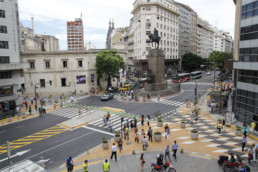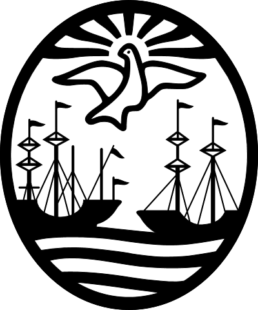Increasing sidewalk space, and building networks of bicycle lanes, has put Buenos Aires on the map as the most bicycle- and pedestrian-friendly city in Argentina.
Under the Healthy Mobility project, Buenos Aires became the first city in Argentina to implement a program focused on increasing the number of pedestrians and cyclists and limiting the number of cars on the road. The project represents a paradigm shift, as the city now puts people before cars, promoting cycling and walking and aiming to reduce the use of cars.

To boost the number of trips made on foot, the city has reclaimed 7,735 m2 to widen sidewalks and redesign intersections to reduce vehicle speed and make crossings safer. A network of on-street protected bike lanes was built and includes 140 km of bi-directional lanes separated by a physical cord from cars for increased protection. The bike lanes are expected to increase by 30.5 km per year. In addition, Buenos Aires also introduced a bike-sharing system to further encourage citizens to choose this sustainable and healthier transportation option.
14,000 tons of CO2 reduced per year
The challenge
Facing a number of issues linked to increasing number of vehicles and traffic congestion, such as a lack of safety for cyclists and pedestrians and worsening air pollution, Buenos Aires introduced the Healthy Mobility project. The project promotes mobility in the city by making streets safe for pedestrians and cyclists.
Co-benefits
Economic The interventions are beneficial for businesses that have installed tables and chairs on the reclaimed pedestrian areas, and reorganized bus stops have increased revenue during peak hours.
Environmental The Healthy Mobility project results in a cleaner environment, as each passenger traveling by car emits 152 grams of CO2 per km, while cycling and walking are emissions free.
Health Before the project, just 0.4% of all trips in Buenos Aires were made by bicycle. Today, 3.5% of trips are made by bike, with the goal of reaching 5% by the end of 2015, significantly increasing the health of the city’s citizens.
Social The city is planning to cover 160 more areas with pedestrian-friendly interventions, mainly including areas vulnerable to high-traffic flows, such as schools and hospitals, improving safety for 400,000 people.
About Buenos Aires
Buenos Aires is the capital and most populous city of Argentina. “Buenos aires” can be translated as “fair winds” or “good airs”. The Greater Buenos Aires conurbation, constitutes the fourth-most populous metropolitan area in the Americas, with a population of around 17 million. Buenos Aires is considered an ‘alpha city’ by the study GaWC5. Buenos Aires’ quality of life was ranked 81st in the world and one of the best in Latin America in 2012, with its per capita income among the three highest in the region. Buenos Aires is a top tourist destination, and is known for its preserved Spanish/European-style architecture and rich cultural life.


